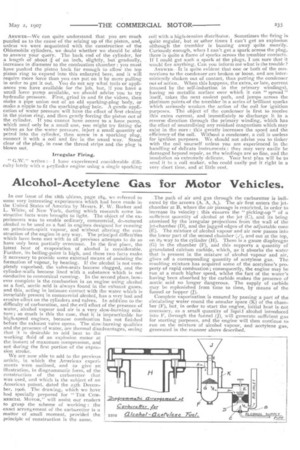Alcohol-Acetylene Gas tor Motor Vehicles.
Page 23

If you've noticed an error in this article please click here to report it so we can fix it.
In our issue of the 38th ultimo, page 384, we referred to some very interesting experiments which had been made in the United States of America by Messrs. F. W. Barker and L. White, of New York, during which research some instructive facts were brought to light. The object of the experiments was to enable ordinary, commercial, de-natured alcohol to be used as a fuel in engines designed for running on petroleum-spirit vapour, and without altering the construction of the engine in any way. The principal difficulties which have been met with in all previous attempts to do so have only been partially overcome. In the first place, the latent heat of evaporation of alcohol is considerable. Further, its boiling-point is high, and these two facts make it necessary to provide some external means of assisting the formation of vapour, by heating. If the alcohol is not completely vaporised, the valve-seats become clogged, and the cylinder-walls become lined with a substance which is not conducive to economical running. In the second place, however complete is the combustion in an engine using alcohol as a fuel, acetic acid is always found in the exhaust gases, and this acting in intimate contact with the water which is invariably present in commercial alcohol, has a very bad and erosive effect on the cylinders and valves. In addition to the difficulty of carburation, and the evil effect of the presence of water, alcohol vapour and air is a very slow-burning mixture; so much is this the case, that it is impracticable for high-speed engines, because combustion has not finished before the exhaust valve opens. The slow-burning qualities and the presence of water, are thermal disadvantages, seeing that it is desirable to add heat to the working fluid of an explosion motor at. the instant of maximum compression, and not during the first portion of the expansion stroke.
We are now able to add to the previous article, in which the American experiments were outlined, and to give art illustration, in diagrammatic form, of the construction of the carburetter that was used, and which is the subject of an American patent, dated the 25th December, 1906. The drawing, which we have had specially prepared for " THE COMMERCIAL MOTOR," Will assist our readers to grasp the scheme of working : the exact arrangement of the carburetter is a matter of small moment, provided the principle of construction is the same.
The path of air and gas through the carburetter is indicated by the arrows (A, A, A,). The air first enters the jetchamber at B, where the air passage is restricted, in order to increase its velocity : this ensures the " picking-up " of a sufficient quantity of alcohol at the jet (C), and its being atomised by the irregular projections from the wall of the jet-chamber (D), and the jagged edges of the adjustable cone (E). The mixture of alcohol vapour and air now passes into the lower part of the second chamber (.), and out at the top, on its way to the cylinder (H). There is a gauze diaphragm (G) in the chamber (E), and this supports a quantity of granulated calcium carbide, which, as it absorbs the water that is present in the mixture of alcohol vapour and air, gives off a corresponding quantity of acetylene gas. The resulting mixture has acquired some of the acetylene's property of rapid combustion ; consequently, the engine may he run at a much higher speed, whilst the fact of the water's having been absorbed by the carbide makes the presence of acetic acid no longer dangerous. The supply of carbide may be replenished from time to time, by means of the funnel or hopper (J).
Complete vaporisation is ensured by passing a part of the circulating water round the annular space (K) of the chamber (11, but, in order to start the engine, initial heat is not necessary, as a small quantity of liquii alcohol introduced into E, through the funnel (J), will generate sufficient gas for starting purposes, and the engine will then continue to run on the mixture of alcohol vapour, and acetylene gas, generated in the manner above described.


























